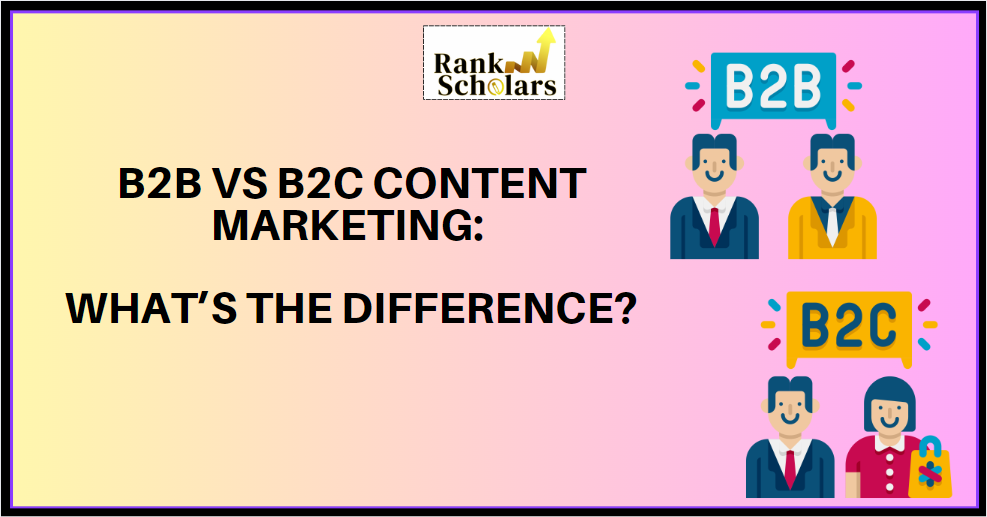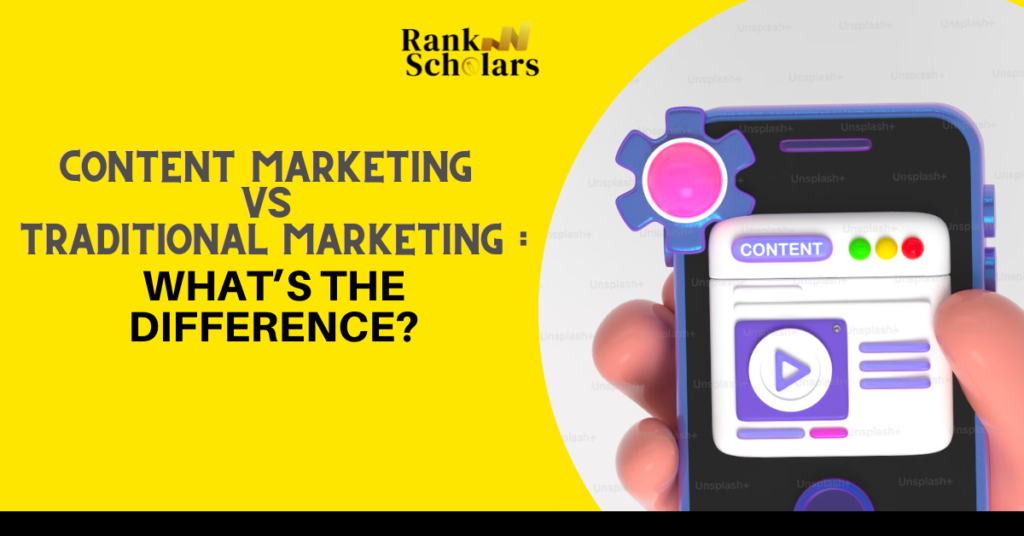Marketing plays a critical role in the success of any business, but the marketing plan is based on whether the messaging is tailored to other businesses (B2B) or individual consumers (B2C). In simple terms, B2B content marketing is all about selling products or services to other businesses, while B2C content marketing targets personal consumers.
With a clear understanding of your target audience’s preferences, you can create a definite marketing program that delivers positive results. And thats why it’s important to have an in-depth knowledge of these two marketing strategies.
In this blog post, we have discussed B2B vs B2C content marketing, exploring their differences as well as their similarities that will help you craft strategies that resonate with your target audience. But first, let’s understand their definitions.
What is B2B Content Marketing?
B2B marketing, short for Business-to-Business marketing, is like the behind-the-scenes action in the business world. It is all about companies selling their products or services to other businesses.
In B2B marketing, the focus is on understanding the needs and challenges of other businesses and offering effective solutions.
For example, imagine a software company that develops project management tools. Their B2B marketing strategy might involve targeting businesses that struggle with organizing their projects and showcasing how their software can streamline workflows, improve collaboration, and boost productivity. They might create informative blog posts, case studies, and demonstrations to illustrate the benefits of their product and convince other businesses to invest in it.
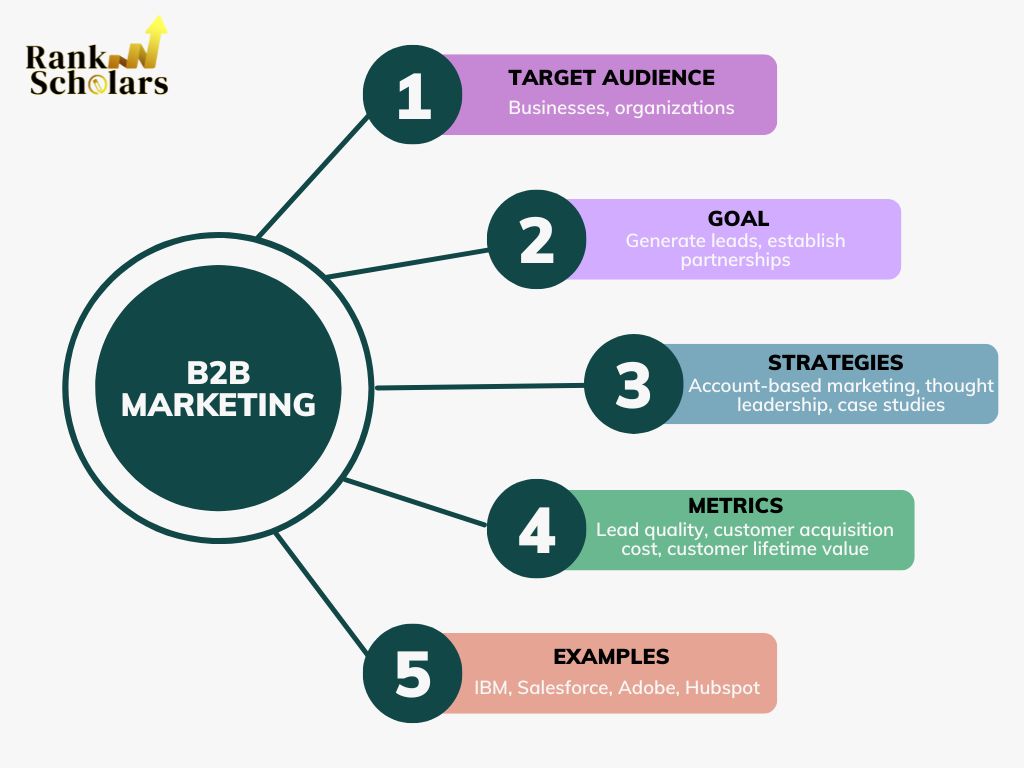
In short, B2B marketing is all about convincing other businesses that your product or service can help them improve their own operations or serve their customers better.
What is B2C Content Marketing?
B2C marketing, which stands for “Business-to-Consumer” marketing, is all about businesses selling products or services to end consumers like you and me. It’s the kind of marketing you see when you’re scrolling through social media, watching TV commercials, or browsing online stores.
In this marketing strategy companies focus on understanding the wants and needs of their target audience and what makes them click that “buy now” button. They might use catchy slogans, flashy ads, or discounts to grab your attention and persuade you to make a purchase.
For example, when you scroll through social media platforms such as Instagram, you might see ads for different products varying from jewelry to skin care products to watches and whatnot. The companies behind those ads use B2C marketing to show off their product and convince you that you absolutely need those in your life. And if you end up buying them, then it means that B2C marketing did its job well.
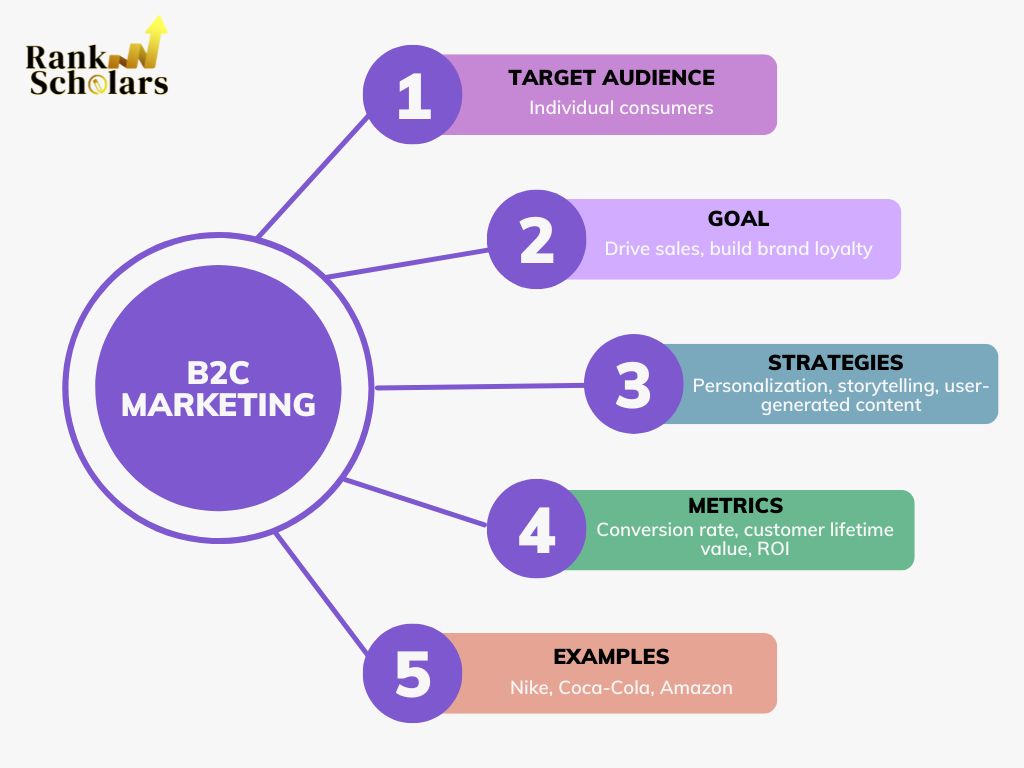
In a nutshell, companies use B2C marketing to convince individuals to buy their stuff.
How’s B2B vs B2C Content Marketing Different?
The approaches and techniques used in B2B and B2C marketing differ significantly. Understanding the difference between these two strategies is crucial for creating content that resonates with the respective target audience. So let’s delve into the key distinctions between B2B and B2C content marketing.
Target Audience
The primary difference between B2B and B2C content marketing is the target audience.
In B2B content marketing, the strategy is made for businesses, professionals, and decision-makers. The audience seeks valuable insights and solutions to address their specific challenges. Content such as white papers, case studies, and webinars are particularly effective in this context, as they offer educational and data-driven information.
B2C content marketing, instead of targeting businesses, aims to appeal to individual people. It is all about connecting emotionally with the consumers. The content used in B2C business is visually attractive, engaging, and easily shareable. They use social media, videos, and influencers to spread brand awareness and interact with customers.
In both cases, understanding the core difference between the target audience is really crucial to creating content that resonates with them.
Content Formats and Channels
Another distinction between the strategies is in the content types and channels used to reach consumers.
In B2B marketing the content format mainly includes detailed resources like white papers, blog posts, case studies, industry reports, webinars, ebooks, and more. The deep insights of these materials guide other businesses in the decision-making process. Social media platforms, particularly LinkedIn along with email marketing, are key channels for distributing B2B content.
In B2C content marketing, content comes in various forms, from catchy social media posts to influencer collaborations. Visual and interactive content, including videos, infographics, and quizzes are widely used in B2C marketing strategy. Channels like Instagram, TikTok, and YouTube, where consumers spend a lot of time are used to distribute the B2C content.
Understanding these distinctions allows marketers to tailor their strategies effectively and drive a meaningful connection with their target audience.
Sales Cycle
The sales dynamics between B2B and B2C marketing are in contrast to each other.
The B2B sales cycle is more like a marathon rather than a sprint. It is a long time process and content, like educational webinars and detailed case studies, helps in this process. The purchasing cycle in B2B depends on several factors that include building personal trust, finding a reliable vendor, involvement of multiple decision-makers like CEOs or CFOs, and considering various options before making a choice.
In B2C business sales cycles are instantaneous, often driven by limited-time offers or flash sales. B2C customers are more interested in what they desire and not what they need, leading to impulse buys. The simplicity of buying something even if it’s not a necessity with just a few clicks encourages impulse purchases, driving B2C sales.
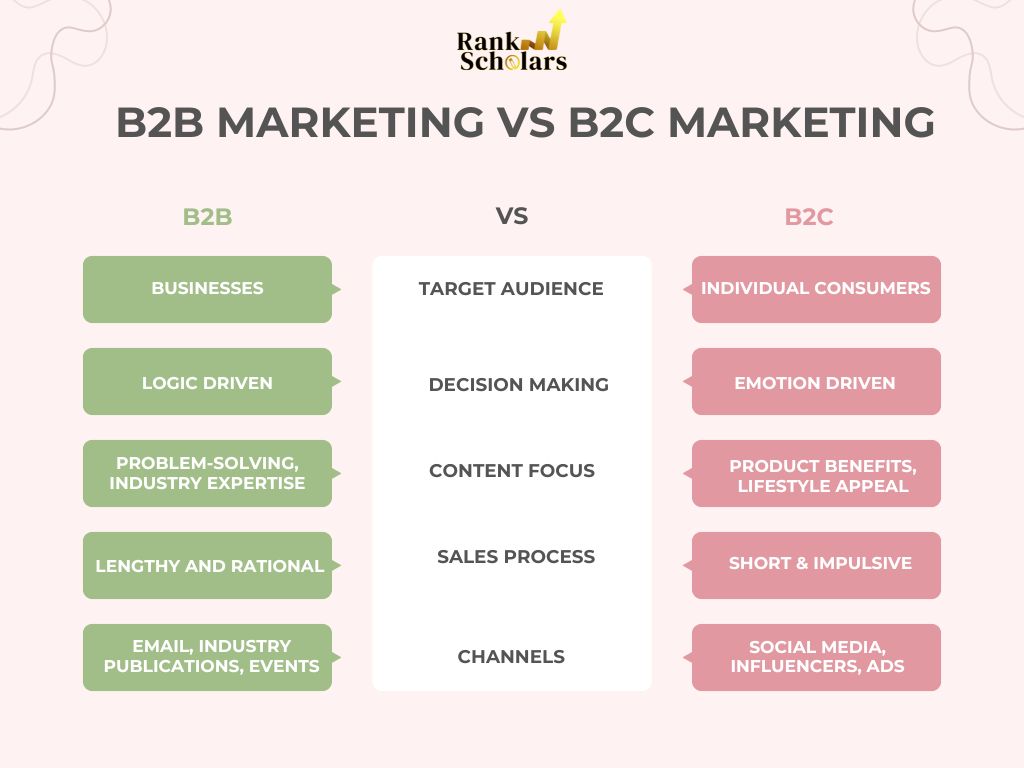
Similarities Between B2B & B2C Content Marketing
B2B and B2C content marketing have several differences but there are a few similarities between the strategies as well.
Storytelling
B2B business transactions seem more straightforward and logical, however, storytelling still plays a vital role. B2B content contains a compelling story that engages decision-makers and convinces them to make a purchase.
In B2C content marketing, storytelling is often front and centre. Consumers connect with brands that tell stories that resonate with their experiences. B2C content tells a story that captivates the audience, making them feel emotionally invested in your brand.
Audience Needs
B2B strategy creates content that addresses the specific needs and pain points of businesses. This content provides valuable insights, solutions, and expertise that help businesses overcome obstacles and achieve their goals.
Similarly, B2C content caters to the needs and desires of consumers. Whether it’s addressing practical concerns, like price and quality, or emotional desires, like status or belonging, B2C content also offers solutions and experiences that resonate with the target audience.
Quality Over Quantity
In B2B content marketing, quality is valued more than quantity. Businesses look for valuable insights and expertise, not just superficial content. The well-researched, insightful, and relevant content plays an important role in earning the trust and respect of your audience.
Similarly, in B2C content marketing, quality trumps quantity. With consumers being exposed to countless messages every day, it’s essential to cut through the noise with content that is meaningful and memorable. Prioritizing content that leaves a lasting impression and fosters a deeper connection with your brand is vital.
6 Best Practices For B2B & B2C Content Marketing
Successful content marketing, whether targeting other businesses (B2B) or individual customers (B2C), is built on a strategic approach that prioritizes audience, value delivery, and the development of meaningful relationships. By adopting best practices for particular needs and preferences, businesses can develop content that resonates, promotes conversions, and cultivates long-term loyalty.
Here are some best practices for both B2B and B2C marketing.
Research Your Audience
The better you know your audience, the more effectively you can create content to meet their needs and preferences. So instead of irrationally crafting content, take the time to thoroughly research and understand the demographics, behaviors, preferences, and pain points of your target audience.
For B2B marketing, this might involve identifying key decision-makers within businesses and understanding their roles, challenges, and priorities.
For B2C marketing, it could mean researching consumer demographics, psychographics, and purchasing behaviors to create detailed buyer personas.
Provide Value
By consistently providing valuable content and experiences, you position your brand as a trusted resource and build loyalty among your audience. This could involve sharing educational content, industry insights, expert advice, or entertaining and inspiring stories.
For B2B marketing, focus on addressing pain points, solving problems, and helping businesses achieve their goals.
For B2C marketing, aim to improve your customers’ lives by meeting their wants, desires, or aspirations.
Build Trust
Trust is essential in both B2B and B2C marketing. Instead of over-promising, be clear about your offer and the value it provides. Trustworthy brands inspire confidence and loyalty, leading to long-term relationships with both businesses and consumers.
For B2B marketing, build trust by demonstrating industry expertise through thought leadership content and providing data-driven solutions tailored to businesses’ specific challenges.
For B2C marketing, showcase authentic customer experiences through testimonials, reviews, and user-generated content.
Use Multiple Channels
By using multiple channels, you can meet your audience where they are and deliver your message effectively across various touchpoints. Reach your audience through a diverse mix of marketing channels to maximize your visibility and engagement.
For B2B marketing, this might include platforms like LinkedIn, industry forums, email newsletters, webinars, and conferences where businesses congregate.
For B2C marketing, consider leveraging social media platforms such as Facebook, Instagram, Twitter, and TikTok as well as search engine marketing, influencer partnerships, and traditional advertising channels.
Data & Analytics
Use the power of data and analytics to track, measure, and analyze the performance of your marketing efforts. Use tools like Google Analytics, CRM systems, and social media insights to gather valuable data about your audience, their behavior, and the effectiveness of your campaigns.
For B2B, utilize data to understand the specific needs and behaviors of businesses, enabling targeted campaigns and tailored messaging that resonate with decision-makers.
In B2C marketing, leverage data to gain insights into consumer preferences and behaviors, allowing for personalized content and targeted advertising that drives engagement and conversions.
Adapt & Innovate
Be flexible and quick to respond when things change in your industry, what people want, and how they behave. Check out new tech, social media, and creative ways to market your business. By being adaptable and innovative, you can keep your business ahead of the game and succeed in selling to both other businesses and regular customers.
For B2B marketing, keep an eye on industry shifts and emerging technologies, experimenting with new approaches and messaging to stay ahead in the market.
For B2C marketing, stay tuned to consumer trends and new platforms, trying out innovative marketing strategies to resonate with your audience.
Wrapping Up
It is important to grasp the distinctions of B2B vs B2C content marketing. While both share the ultimate goal of driving engagement and conversions, the approaches diverge significantly based on the target audience. By following best practices like providing value, building trust, and staying adaptable, businesses can create content that resonates with their audience and drives success in both B2B and B2C markets. In the end, it’s about connecting with people in a way that makes them want to choose your brand over the competition.

Sahanaj is a content writer who is passionate about turning ideas into words that inspire positive change.

